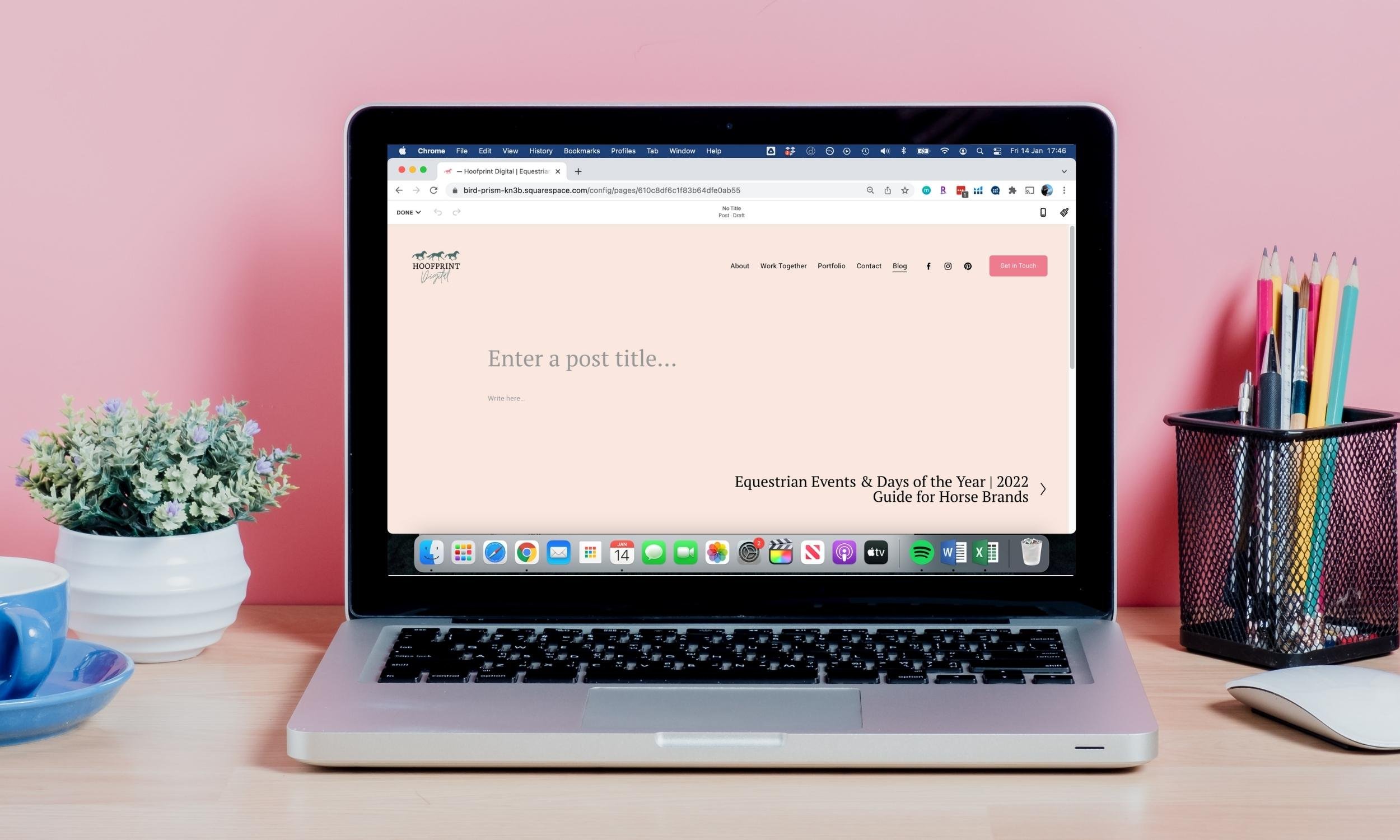How to Start a Successful Equestrian Blog | 2022 Guide
So, you want to start an equestrian blog? Well, you’re in the right place. I’ll take you through all the stages so you can get started blogging about equestrian products, the horse lifestyle topics, or whatever equine topics take your fancy!
In this guide:
Why You Need an Equestrian Blog
A blog is a great addition to your website if you are a product or service-based equestrian business. They are also a useful way for riders or trainers to build their brand.
Trust – demonstrates your knowledge to position you as an expert in the equestrian industry.
SEO – high-quality blog posts with relevant keywords will improve your brand’s visibility and ranking in search engine results.
Traffic – new customers can discover your brand by reading the blog. Links posted on your social media will also drive customers to your website.
Sales – promote your products/services by integrating them into blog posts. It’s not a hard sell but is a great way to inform and educate customers too.
Connect – reach your target audience by providing the information they’re seeking. You can also create an affinity for your brand by engaging customers.
How to Set Up an Equestrian Blog
If you have a website, chances are there is already a blog section integrated into the design. Platforms such as Shopify, WordPress, and Squarespace have a blog feature that you will just need to activate. Make sure a link to the blog is in your website’s navigation menu and then all your new posts will automatically be added to this section.
If you don’t have a website yet don’t panic! WordPress offers a free plan which is a great option when you’re starting out. This does have limitations though. You’ll have restricted storage space and the domain name of your blog will contain .wordpress.com, e.g. www.hoofprintdigital.wordpress.com.
When you’re ready, I’d recommend moving onto a self-hosted version of WordPress. This means you’ll pay a small amount each month for your blog to be hosted online and then you can purchase a custom domain name.
Alternatively, if you don’t want to faff around with hosting, a platform like Shopify or Squarespace sorts all this out for you. Some of these plans will also include a free custom domain name for the first year. Make sure you don’t let the domain name registration lapse after the first year, or other people will be able to buy your blog’s name. You can set it up to automatically renew but often it’s cheaper to purchase it through a dedicated domain name site such as Namecheap after the free year has concluded, so it’s worth shopping around.
Squarespace also has a scheduling tool that allows customers to book appointments, lessons, and more which is super helpful if you're a service-based business. For e-commerce brands, I'd recommend Shopify which is designed to help you sell.
Writing Your First Blog Post
Now that your blog is set up it’s time to write your first post! I typically draft my posts in a Word document first and then copy the text across. There a few key elements that you’ll need to include in your blog post:
Title - what’s your blog post about? Try to include keywords and make it enticing enough for readers to want to click on it.
Introduction - before jumping straight in, set up what the post is about. The intro doesn’t need to be long but should leave your readers wanting more.
Headings & Sections - no one likes a big block of text. You’ll want to break it up and make use of headings to guide your reader through the post. We’ll talk more about headings and their benefit for SEO later.
Images - a picture tells a thousand words, right? So maybe we’re not going as far as swapping one picture for your whole blog post but make sure to include relevant images to add interest. You’ll also be able to add a featured image. This is similar to a thumbnail and will display when you share the link on social media.
Links - blog posts provide the opportunity to promote your products and services organically. If you’re talking about show turnout and you sell hoof oil and plaiting bands, make sure they’re linked. Equally, if you’re writing about stretches to keep your horse supple and you’re a massage therapist, include a link to book a consultation or appointment with you.
Horse Topics to Write About
Fed up of staring at a blank screen? It’s ok, I get it! Coming up with new blog ideas for your equestrian brand can be tricky. Here are a few ideas to get you started for different businesses in the horse industry.
Tack Shops/Retailers/Manufactures
Introducing new products e.g. ‘Introducing our New Mint Matchy Matchy Collection’
Product guide e.g. ‘XC Boots Explained’
Seasonal post e.g. ‘Christmas Gift Guide’ or ‘The Ultimate Pony Club Camp Guide’
Riders/Instructors/Trainers
Your essentials e.g. ‘My Eventing Essentials’
Expert advice e.g. ‘Three Schooling Exercises to Improve your Dressage Marks’
Competition write-up e.g. ‘Top Hats & Tails: Our First Grand Prix Competition’
Equine Care Services - Vet / Massage Therapist / Nutritionist / Farrier / Saddle Fitter etc.
Preparation guide e.g. ‘What to Expect at your Saddle Fitting Appointment’
Expert advice e.g. ‘Feeding the Good Doer’
Behind-the-scenes e.g. ‘A Day in the Life of an Equine Vet’
If you’re still not sure what to write, get in touch with me! I’m an equestrian myself so love chatting about all things horses. After brainstorming lots of ideas that your customers will love reading about, I can even take care of writing the blog content.
Before Pressing Publish
You’ve finally finished your blog post and you’re so excited to hit publish but hang on! There are a few things you’ll want to check first so that a) people find your blog posts and b) they enjoy reading your blog and come back for more.
Editing is a crucial part of the blog writing process. I get it, you've spent ages writing the content and don't want to look at it any longer. Take some time away from the screen before coming back to it with fresh eyes. Correct any typos and then tighten up any areas where you've wandered off-topic.
If possible, get someone else to read your work. They're bound to spot things you've missed and can ensure everything is clear; often you're just too close to the work itself to notice if something isn't reading as you intended it to.
I also offer an editing service if you need someone with an equestrian background to look over your blog post.
SEO Considerations
SEO (Search Engine Optimisation) improves your site’s visibility in search engine results. You’ll want to rank highly for keywords related to your business.
For example, if you’re a riding instructor, you’ll want to show up when people Google “Riding lessons in [your location]”, “Horse riding in [your location]”, “How to Learn to Horse Ride” etc.
Having a blog helps you rankly highly as you’re increasing the number of keywords on your site, adding fresh content, and building your brand’s reputation.
There are a few technical things you can do before publishing your blog though. These include:
Headings
You’ll want the H1 tag to be for the title of your blog but subsequent headings and subheadings should be H2, H3, etc. to help readers navigate your post.
Images
Including images automatically makes your blog post more appealing but you want to make sure they are resized. Uploading huge files will slow your website down.
You’ll also want to give the image a related name e.g. “horse-tack-cleaning.jpg” rather than “IMG12345.jpg”.
When uploading the image, you can add alt text. This is what’s displayed if your image can’t be shown for any reason, or helps readers with a visual impairment. Include keywords here but also make sure you’re actually describing the image e.g. “Cleaning a horse’s saddle with a sponge and tack cleaner”.
Title Tag
Hopefully, you’re already written a catchy title for your blog post but the title tag is what displays in search engine results, the tab of your browser, and in social media link previews.
You might want to include additional information in your title tag such as your brand’s name, or other relevant keywords. For example, if your blog title is “A Quick Guide to Tack Cleaning”, the title tag could be “A Quick Guide to Tack Cleaning | Hoofprint Digital”, or “A Quick Guide to Tack Cleaning – Horse Saddle & Bridle”. Google cuts off the title after roughly 60 characters so try to keep it below this.
Meta Description
This is the summary that will be displayed under your blog post title in search engine results. It will be generated automatically if you don’t provide one but it’s a good opportunity to add relevant keywords and compel people to read your blog.
Current guidance from Google recommends roughly 155-160 characters
Internal Links
These are links to other pages on your website. Not only does it point to other relevant content for your readers but helps search engines to see what content on your website is related.
This is where you’ll want to link to the products and services you offer that are topical to the post, as well as other blog posts.
Sharing is Caring
Once your blog post is published, you’ll want to get people reading it. Share links to the blog post on social media, or even some excerpts. If you have an email newsletter, you can mention the blog post there too.
Another way to build up the readership of your blog is to write a guest blog for someone else. Perhaps there is another local equestrian business you can collaborate with, or someone else in your niche.
Ask if they accept guest blog submissions and then you can include a link back to your blog. By finding another blogger who has an audience similar to your own, they are more likely to be interested in what you're writing about, and subsequently the products/services you offer.
Then, you just have to repeat the process and before you know it you’ll have a growing collection of equine blog posts. Make blog posts a part of your overall digital strategy and they’ll become an invaluable way to grow your brand and reach new customers.
If this all sounds like too much time and work then get in touch! I offer equestrian blog writing services so you focus on running your business. I can also help with setting up your blog or website, as well as your overall digital marketing strategy.






